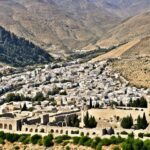Mount Gerizim, located in the West Bank near the biblical site of Shechem, holds significant historical and religious importance in both Samaritan and Judaic traditions. Rising to 2,890 feet above sea level, it is a twin of Mount Ebal, with a valley separating the two. Mentioned in the Hebrew Bible as the site of God’s blessing on the Jewish people, Mount Gerizim has been revered for centuries.
During the Second Temple period, the Samaritans built a shrine on Mount Gerizim, which remains a place of religious ceremonies to this day. Its strategic importance and connection to the biblical city of Shechem further enhance its historical significance.
Join us on a journey to explore the history, geography, and cultural practices associated with Mount Gerizim, as well as its archaeological discoveries and theological themes. Discover the rich tapestry of Mount Gerizim’s lore and its enduring impact on the hearts and minds of those who regard it with reverence.
Key Takeaways:
- Mount Gerizim holds historical and religious significance in Samaritan and Judaic traditions.
- It is mentioned in the Hebrew Bible as the site of God’s blessing on the Jewish people.
- The Samaritans built a shrine on Mount Gerizim during the Second Temple period.
- Mount Gerizim’s archaeological discoveries and connection to Shechem add to its historical importance.
- Theological themes associated with Mount Gerizim resonate in both Samaritan and Judaic faiths.
Historical Significance of Mount Gerizim
Mount Gerizim holds a rich historical legacy that spans thousands of years, leaving an indelible mark on various cultures and religions. Its significance is documented in multiple ancient texts and chronicles, affirming its enduring importance.
The Hebrew Bible and the Talmud make specific mention of Mount Gerizim, highlighting its connection to significant events and religious practices. Additionally, the renowned Roman Jewish historian Flavius Josephus references the mountain in his writings, further solidifying its historical relevance.
One pivotal aspect of Mount Gerizim’s history is its association with the Samaritans, a group that claims to represent the pre-Babylonian Exile Israelite religion. During the Second Temple period, the Samaritans constructed a shrine on the mountain, thereby establishing it as their primary place of worship. This marked a defining moment in their religious and cultural identity.
Another key element that enhances Mount Gerizim’s historical significance is its connection to the ancient city of Shechem. This nexus amplifies the historical narratives and the cultural impact of the region, drawing attention to the mountain’s role in the broader historical context.
Mount Gerizim’s historical importance cannot be overlooked. Its mention in ancient texts, such as the Hebrew Bible and the Talmud, coupled with references by renowned scholars like Flavius Josephus, solidify its status as a site of profound historical significance.
In summary, the historical significance of Mount Gerizim is rooted in its documented mentions in ancient texts and the establishment of the Samaritan shrine during the Second Temple period. The profound influence of the mountain on the region’s history, coupled with its connection to the biblical city of Shechem, enriches our understanding of its enduring importance.
Geographical Location of Mount Gerizim
Mount Gerizim is located in the West Bank, just south of Nablus. Rising about 500 meters above the ancient city of Flavia Neapolis, it offers breathtaking views of the surrounding landscape.
The northern slopes of Mount Gerizim are densely forested, creating a picturesque setting for visitors. From the mountain’s summit, one can overlook the bustling city of Nablus, with its rich history and vibrant culture. The archaeological site of Tell Balata, an ancient Canaanite and Israelite city, lies nearby, further adding to the region’s historical significance.
Surrounded by fertile agricultural land to the east, Mount Gerizim stands as a testament to the natural beauty and abundance of this biblical land.
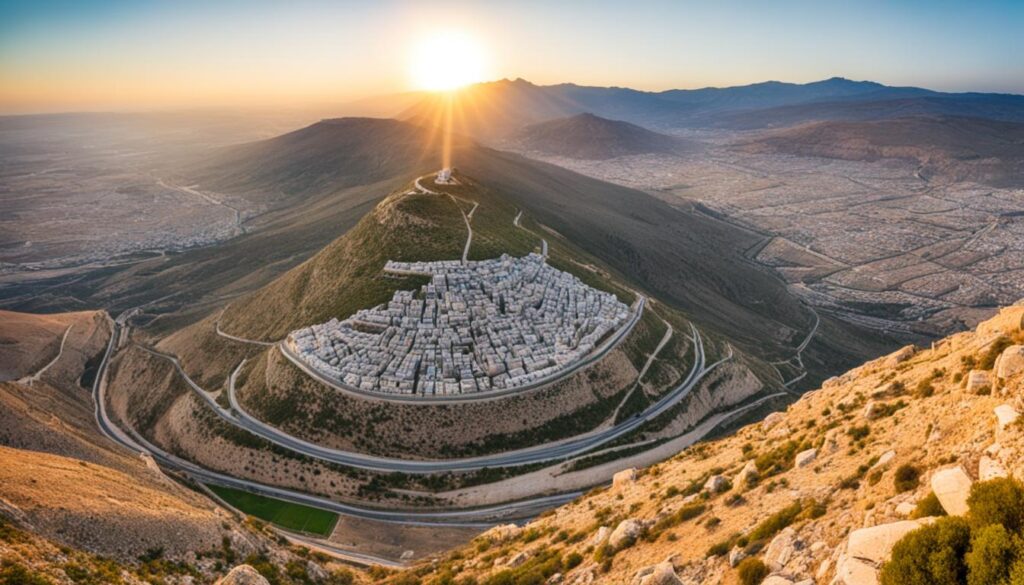
Natural Beauty and Cultural Heritage
The diverse flora and fauna that thrive on Mount Gerizim contribute to its unique charm. The lush greenery and fragrant wildflowers paint a vivid tapestry against the mountain’s ancient rocky slopes.
But Mount Gerizim’s appeal isn’t limited to its scenic beauty. The mountain holds deep cultural and spiritual significance for various communities, which adds to its allure as a destination for visitors seeking to explore its historical heritage.
“Mount Gerizim is not just a mountain; it’s a place where the past, present, and future converge. Its beauty transcends physical boundaries, inspiring both awe and reverence.”
– Local Historian
Whether you are a nature enthusiast, a history buff, or a spiritual seeker, Mount Gerizim offers a captivating destination that will leave a lasting impression.
| Key Features | Details |
|---|---|
| Location | West Bank, just south of Nablus |
| Elevation | Approximately 500 meters |
| Scenic Views | Overlooks the city of Nablus and the archaeological site of Tell Balata |
| Vegetation | Densely forested northern slopes |
| Agricultural Land | Surrounded by fertile land to the east |
Archaeological Discoveries on Mount Gerizim
Archaeological evidence has revealed fascinating insights into the ancient history of Mount Gerizim. The discovery of a temple dating back to the Persian period around 450 B.C.E. stands as a testament to the enduring significance of this sacred mountain. The temple complex underwent expansion during the Hellenistic period, serving as a place of worship until its destruction by the Maccabees in 110 B.C.E.
The ruins of the temple, along with other structures and inscriptions, have been unearthed on Mount Gerizim, providing a glimpse into the religious practices and cultural life of ancient communities. These findings offer valuable insights into the complex interplay of faith, tradition, and historical events that took place on this revered mountain.
The Comparison with Mount Ebal
“Mount Gerizim is often compared to its twin mountain, Mount Ebal, which also holds significant archaeological importance in the region. The exploration and comparison of these two mountains contribute to a deeper understanding of the historical and cultural dynamics of ancient societies in this area.”
The exploration of Mount Gerizim’s archaeological treasures, combined with the study of Mount Ebal, enriches our understanding of the region’s ancient history. These comparative discoveries shed light on the cultural practices and historical development of the societies that inhabited this profound and sacred landscape.
Theological Themes Associated with Mount Gerizim
Mount Gerizim holds significant theological importance in both Samaritan and Judaic traditions. The mountain is considered the primary place of worship by the Samaritans, who believe it was chosen by Moses as the site for offering blessings. In their interpretation of the scripture, a version of the Torah, Mount Gerizim takes precedence over Jerusalem.
In Judaism, Mount Gerizim is mentioned in the Hebrew Bible and is associated with blessings and sacred ceremonies. It holds a place of reverence and plays a role in the religious practices and rituals of the Jewish faith.
“And the children of Israel … he shall cause to stand upon Mount Gerizim to bless the people.”
The significance of Mount Gerizim in both Samaritan and Judaic traditions highlights its role as a sacred site and a symbol of faith. The mountain’s connection to blessings and divine favor underscores its importance in the religious narratives of these communities.
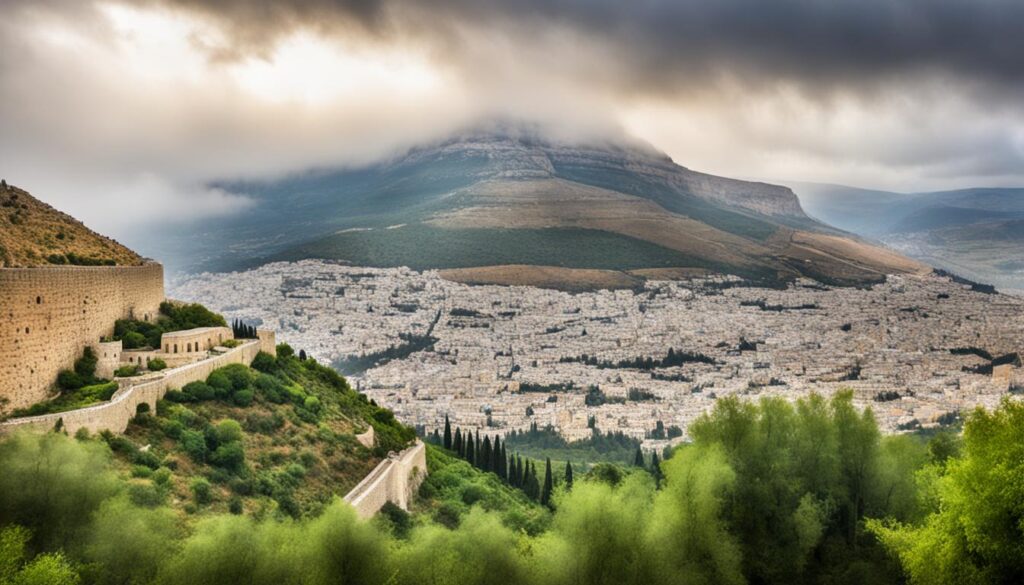
The image above showcases the breathtaking view from Mount Gerizim, capturing the serene beauty of the sacred mountain that resonates with both Samaritan and Judaic traditions.
Key Biblical Events on Mount Gerizim
Mount Gerizim holds a prominent place in the Hebrew Bible and is associated with significant events that shape its biblical significance. One of the notable occurrences on Mount Gerizim is the ceremony in which God was to pronounce blessings upon the Jewish people. This event is recorded in the book of Joshua, emphasizing the mountain’s role as a site of divine favor and blessings.
The Samaritans, who hold Mount Gerizim in high regard, also believe that the mountain is connected to the near-sacrifice of Abraham’s son, Isaac. According to their tradition, Mount Gerizim is the exact location where Abraham demonstrated his unwavering faith and commitment to God’s command. This event further accentuates the mountain’s biblical significance and its deep-rooted tie with the faith and beliefs of Samaritan and Judaic traditions.
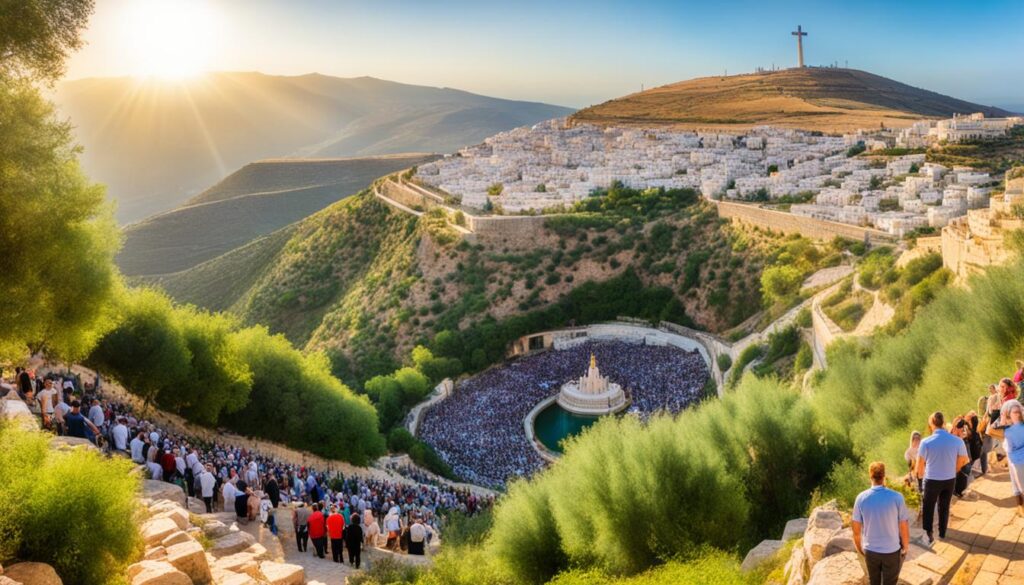
Cultural and Religious Practices on Mount Gerizim
The Samaritans, who follow a unique form of the pre-Babylonian Exile Israelite religion, have their religious center on Mount Gerizim. They perform religious ceremonies on the mountain, including the sacrifice of the Paschal lamb during Passover. Their religious practices and cultural traditions, such as pilgrimages and rituals, are centered around Mount Gerizim.
“Mount Gerizim is a sacred place for the Samaritans, serving as the focal point of their religious and cultural identity,” says Dr. Rachel Cohen, an expert in religious studies. “Their belief system and practices revolve around this mountain, which they consider to be the true location of God’s chosen dwelling.”
One of the most important practices for the Samaritans is the annual Passover sacrifice, which takes place on Mount Gerizim. This ceremony involves the sacrifice of a lamb, symbolizing the Exodus story and the liberation of the Israelites from slavery in Egypt. The Samaritans gather on the mountain to perform this ritual, preserving their ancient traditions and maintaining their unique religious heritage.

The cultural significance of Mount Gerizim extends beyond religious practices. The mountain serves as a pilgrimage site for the Samaritans, who believe that it was the chosen location for God’s blessings. Pilgrims from around the world travel to Mount Gerizim to experience its spiritual energy and connect with their shared traditions.
The Role of Mount Gerizim in Samaritan Identity
Mount Gerizim holds immense importance in defining the identity of the Samaritans. Throughout history, the mountain has served as a symbol of their faith, resilience, and distinctiveness. It is a tangible link to their historical roots and a reminder of their enduring commitment to their religious beliefs.
| Key Cultural and Religious Practices on Mount Gerizim | Significance |
|---|---|
| Pilgrimages | Strengthen spiritual connection and faith through communal gatherings |
| Passover Sacrifice | Adherence to ancient traditions and commemoration of the Exodus story |
| Prayer and Worship | Engagement in spiritually fulfilling rituals on the sacred mountain |
| Religious Festivals | Celebration of significant dates and events in the Samaritan calendar |
The cultural and religious practices on Mount Gerizim serve as a testament to the rich and vibrant Samaritan heritage. These practices create a sense of unity and belonging among the Samaritan community, strengthening their bond with one another and with their ancestral traditions. Mount Gerizim continues to be a place of devotion, celebration, and cultural expression for the Samaritans, embodying their deep-rooted faith and identity.
Prophetic and Eschatological Significance of Mount Gerizim
Mount Gerizim holds immense prophetic and eschatological significance in biblical and Judaic theology. It is intricately linked to blessings and the fulfillment of divine promises. In various interpretations and traditions, there is a belief that the future Messiah will come to Mount Gerizim, leading to the restoration of the Samaritan faith. This spiritual and holy mountain is associated with salvation and divine intervention, making it a beacon of hope and devotion.
“And it shall come to pass, when the Lord your God brings you into the land you are entering to take possession of, that you shall set the blessing on Mount Gerizim and the curse on Mount Ebal.” – Deuteronomy 11:29
Mount Gerizim’s significance extends beyond its geographic presence. It embodies the eternal promises and prophecies, captivating the hearts and minds of believers. The biblical connection to this sacred mountain resonates deeply within the Jewish faith, fostering a sense of reverence and awe.
The Restoration of the Samaritan Faith
Within Samaritan tradition, Mount Gerizim holds a pivotal role in the restoration of their faith. The Samaritans, who trace their lineage back to the northern kingdom of Israel, regard Mount Gerizim as the chosen place for divine worship. Their ancient scripture, a version of the Torah, highlights the importance of Mount Gerizim as the sacred site for blessings and spiritual communion.
According to Samaritan beliefs, Mount Gerizim plays a central role in the eschatological future, when their faith will be revitalized, and their long-awaited Messianic era will be ushered in. They view Mount Gerizim as the beacon of salvation and the ultimate destination for the unfolding of God’s divine plan.
The Divine Promises and Blessings
In Jewish theology, Mount Gerizim is associated with divine blessings and sacred ceremonies. It is deeply entrenched in the Hebrew Bible, where God is depicted as blessing the Jewish people from this mountain. The elevation of Mount Gerizim symbolizes the close proximity between individuals and the divine, allowing for the outpouring of divine blessings upon humankind.
Explore the powerful symbolism and spiritual significance of Mount Gerizim in the following table:
| Biblical Significance | Prophetic Promise |
|---|---|
| Mount Gerizim is the site where blessings are pronounced upon the Jewish people. | In the future, the mountain is believed to play a role in the restoration of the Samaritan faith. |
| It signifies the close connection between God and humanity, through the outpouring of divine blessings. | The sacred mountain stands as a beacon of hope and spiritual fulfillment. |
| Mount Gerizim symbolizes the fulfillment of divine promises throughout history. | Believed to be the place where the future Messiah will come, bringing salvation and restoration. |
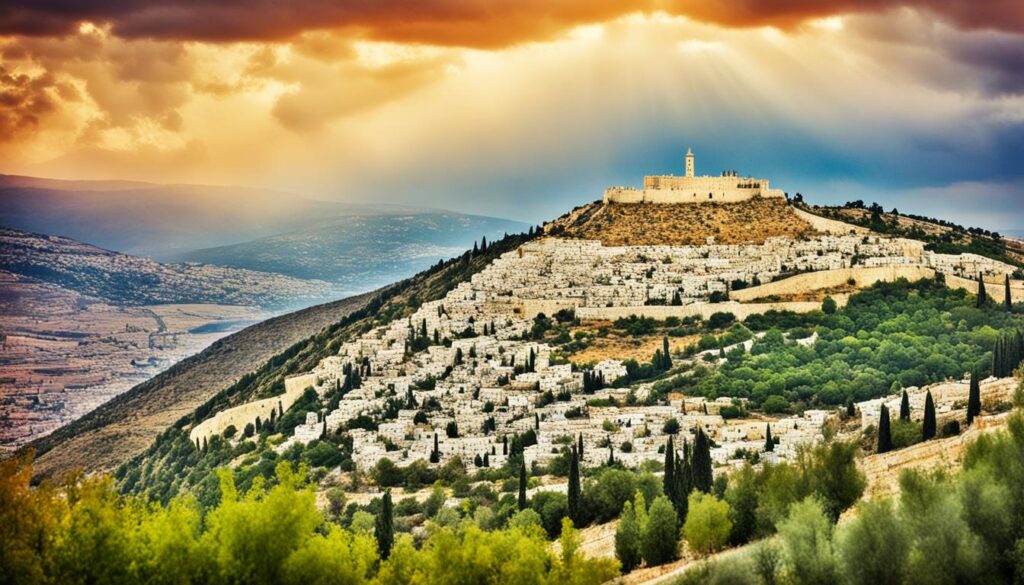
Conclusion
Mount Gerizim, as portrayed in the Bible, holds immense significance in Judaism and the Samaritan religion. This mountain’s remarkable history, geographical location, archaeological discoveries, and theological themes have cemented its place as a sacred site in both traditions.
From being the site of divine blessings in the Hebrew Bible to serving as the primary place of worship for the Samaritans, Mount Gerizim plays a pivotal role in shaping sacred history. Its association with key biblical events and its role in cultural and religious practices further solidify its importance in Judeo-Samaritan traditions.
Today, Mount Gerizim stands as a symbol of faith and a living connection to the ancient past for both Samaritans and Jews. Its enduring legacy and spiritual significance continue to inspire and influence religious practices, pilgrimages, and ceremonies performed on its sacred slopes.


